Polarimetric SAR Decomposition Method Based on Modified Rotational Dihedral Model
Abstract
:1. Introduction
2. Modified Rotational Dihedral Model
2.1. Scattering Mechanism of Rotational Dihedral
2.2. Derivation of MRDM
2.3. Precision Analysis of MRDM
2.4. The Coherency Matrix of MRDM
3. Five-component Scattering Decomposition
3.1. Orientation Angle Estimation
3.2. Five-component Scattering Decomposition (MRDM-5SD)
3.3. Branch Conditions and Flowchart of MRDM-5SD
3.4. Solutions of MRDM-5SD
4. Experimental Results and Discussion
4.1. Validation by Spaceborne ALOS-2/PALSAR-2 Datasets
4.2. Validation by Spaceborne GF-3 Datasets
4.3. Validation by Airborne E-SAR Datasets
4.4. Building Detection for ALOS-2/PALSAR-2 Datasets
5. Conclusions
Author Contributions
Funding
Data Availability Statement
Conflicts of Interest
References
- Lee, J.S.; Pottier, E. Overview of polarimetric radar imaging. In Polarimetric Radar Imaging from Basics to Applications; Taylor & Francis Group: Boca Raton, FL, USA, 2009; pp. 5–13. [Google Scholar]
- Cloude, S.R. Depolarisation and scattering entropy. In Polarization Applications in Remote Sensing; Oxford University Press: Oxford, UK, 2010; pp. 71–118. [Google Scholar]
- Aghababaee, H.; Sahebi, M.R. Model-based target scattering decomposition of polarimetric SAR tomography. IEEE Trans. Geosci. Remote Sens. 2018, 56, 972–983. [Google Scholar] [CrossRef]
- Pallotta, L.; Orlando, D. Polarimetric covariance eigenvalues classification in SAR images. IEEE Geosci. Remote Sens. Lett. 2019, 16, 746–750. [Google Scholar] [CrossRef]
- Li, Y.; Yin, Q.; Lin, Y.; Hong, W. Anisotropy scattering detection from multiaspect signatures of circular polarimetric SAR. IEEE Trans. Geosci. Remote Sens. 2018, 15, 1575–1579. [Google Scholar] [CrossRef]
- Liu, C.; Yang, J.; Ou, J.; Fan, D. Offshore bridge detection in Polarimetric SAR images based on water network construction using Markov tree. Remote Sens. 2022, 14, 3888. [Google Scholar] [CrossRef]
- Zhang, T.; Wang, W.; Yang, Z.; Yin, J.; Yang, J. Ship detection from PolSAR imagery using the hybrid polarimetric covariance matrix. IEEE Geosci. Remote Sens. Lett. 2021, 18, 1575–1579. [Google Scholar] [CrossRef]
- Li, H.; Cui, X.; Chen, S.; Yang, J. PolSAR ship detection with optimal polarimetric rotation domain features and SVM. Remote Sens. 2021, 13, 3932. [Google Scholar] [CrossRef]
- Richards, J.A. Interpretation based on structural models. In Remote Sensing with Imaging Radar; Springer: Berlin/Heidelberg, Germany, 2009; pp. 281–301. [Google Scholar]
- Cui, Y.; Yamaguchi, Y.; Yang, J.; Kobayashi, H.; Park, S.; Singh, G. On complete model-based decomposition of polarimetric SAR coherency matrix data. IEEE Trans. Geosci. Remote Sens. 2014, 52, 1991–2001. [Google Scholar] [CrossRef]
- An, W.; Lin, M. An incoherent decomposition algorithm based on polarimetric symmetry for multilook polarimetric SAR data. IEEE Trans. Geosci. Remote Sens. 2020, 58, 2383–2397. [Google Scholar] [CrossRef]
- Mohanty, S.; Singh, G. Improved POLSAR model-based decomposition interpretation under scintillation conditions. IEEE Trans. Geosci. Remote Sens. 2019, 57, 7567–7578. [Google Scholar] [CrossRef]
- Ainsworth, T.L.; Wang, Y.; Lee, J.S. Model-based polarimetric SAR decomposition: An L1 regularization approach. IEEE Trans. Geosci. Remote Sens. 2022, 60, 5208013. [Google Scholar] [CrossRef]
- Freeman, A.; Durden, S.L. A three-component scattering model for polarimetric SAR data. IEEE Trans. Geosci. Remote Sens. 1998, 36, 963–973. [Google Scholar] [CrossRef] [Green Version]
- Singh, G.; Yamaguchi, Y.; Park, S. General four-component scattering power decomposition with unitary transformation of coherency matrix. IEEE Trans. Geosci. Remote Sens. 2013, 51, 3014–3022. [Google Scholar] [CrossRef]
- Chen, S.; Wang, X.; Xiao, S.; Sato, M. General polarimetric model-based decomposition for coherency matrix. IEEE Trans. Geosci. Remote Sens. 2014, 52, 1843–1855. [Google Scholar] [CrossRef]
- Yamaguchi, Y.; Moriyama, T.; Ishido, M.; Yamada, H. Four-component scattering model for polarimetric SAR image decomposition. IEEE Trans. Geosci. Remote Sens. 2005, 43, 1699–1706. [Google Scholar] [CrossRef]
- Sato, A.; Yamaguchi, Y.; Singh, G.; Park, S. Four-component scattering power decomposition with extended volume scattering model. IEEE Geosci. Remote Sens. Lett. 2012, 9, 160–171. [Google Scholar] [CrossRef]
- Yamaguchi, Y.; Sato, A.; Boerner, W.; Sato, R.; Yamada, H. Four-component scattering power decomposition with rotation of coherency matrix. IEEE Trans. Geosci. Remote Sens. 2011, 49, 2251–2258. [Google Scholar] [CrossRef]
- Singh, G.; Yamaguchi, Y. Model-based six-component scattering matrix power decomposition. IEEE Trans. Geosci. Remote Sens. 2018, 56, 5687–5704. [Google Scholar] [CrossRef]
- Singh, G.; Malik, R.; Mohanty, S.; Rathore, V.S.; Yamada, K.; Umemura, M.; Yamaguchi, Y. Seven-component scattering power decomposition of POLSAR coherency matrix. IEEE Trans. Geosci. Remote Sens. 2019, 57, 8371–8382. [Google Scholar] [CrossRef]
- Maurya, H.; Panigrahi, R.K. PolSAR coherency matrix optimization through selective unitary rotations for model-based decomposition scheme. IEEE Geosci. Remote Sens. Lett. 2019, 16, 658–662. [Google Scholar] [CrossRef]
- Wang, Y.; Yu, W.; Liu, X.; Wang, C.; Kuijper, A.; Guthe, S. Demonstration and analysis of an extended adaptive general four-component decomposition. IEEE J. Sel. Top. Appl. Earth. Obs. Remote Sens. 2020, 13, 2573–2586. [Google Scholar] [CrossRef]
- Yin, Q.; Xu, J.; Xiang, D.; Zhou, Y.; Zhang, F. Polarimetric decomposition with an urban area descriptor for compact polarimetric SAR data. IEEE J. Sel. Top. Appl. Earth. Obs. Remote Sens. 2021, 14, 10033–10044. [Google Scholar] [CrossRef]
- Zhang, L.; Chen, Y.; Wang, N.; Zou, B.; Liu, S. Scattering mechanism analysis of man-made targets via polarimetric SAR observation simulation. IEEE J. Sel. Top. Appl. Earth. Obs. Remote Sens. 2022, 15, 919–929. [Google Scholar] [CrossRef]
- Gordon, W. Far-field approximations to the Kirchoff-Helmholtz representations of scattered fields. IEEE Trans. Antennas Propag. 1975, 23, 590–592. [Google Scholar] [CrossRef]
- Giorgio, F.; Riccio, D. Analytic formulations of electromagnetic scattering. In Scattering, Natural Surfaces, and Fractals; Elsevier: Burlington, MA, USA, 2006; p. 130. [Google Scholar]
- Chai, S.R.; Guo, L.X.; Li, K.; Li, L. Combining CS with FEKO for fast target characteristic acquisition. IEEE Trans. Antennas Propag. 2018, 66, 2494–2504. [Google Scholar] [CrossRef]
- Lee, J.S.; Schuler, D.L.; Ainsworth, T.L. Polarimetric SAR data compensation for terrain azimuth slope variation. IEEE Trans. Geosci. Remote Sens. 2000, 38, 2153–2163. [Google Scholar]
- Chen, Q.; Jiang, Y.M.; Zhao, L.J.; Kuang, G.Y. Polarimetric scattering similarity between a random scatterer and a canonical scatterer. IEEE Geosci. Remote Sens. Lett. 2010, 7, 866–869. [Google Scholar] [CrossRef]
- Maurya, H.; Panigrahi, R.K. Investigation of branching conditions in model-based decomposition methods. IEEE Geosci. Remote Sens. Lett. 2018, 15, 1224–1228. [Google Scholar] [CrossRef]



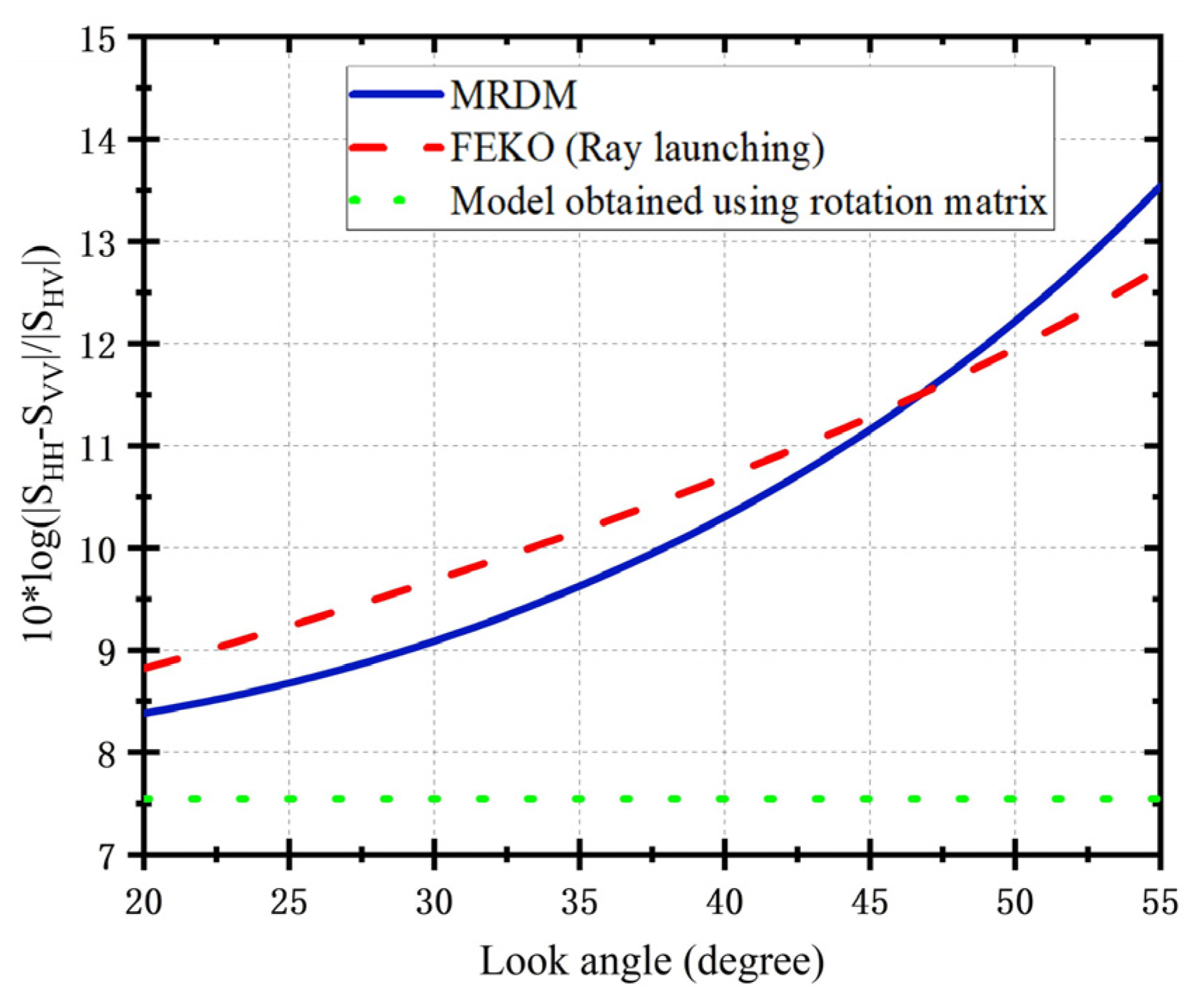
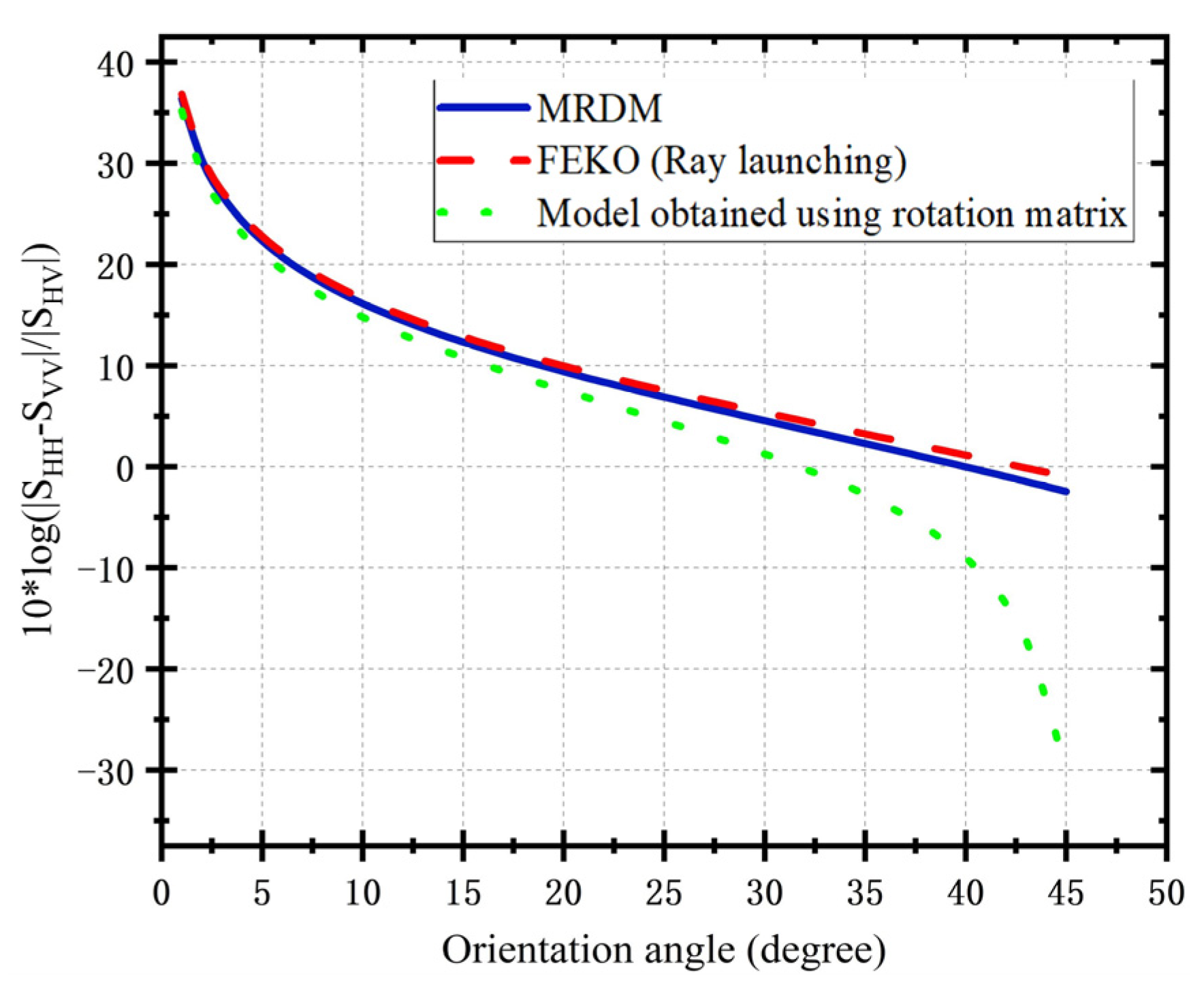


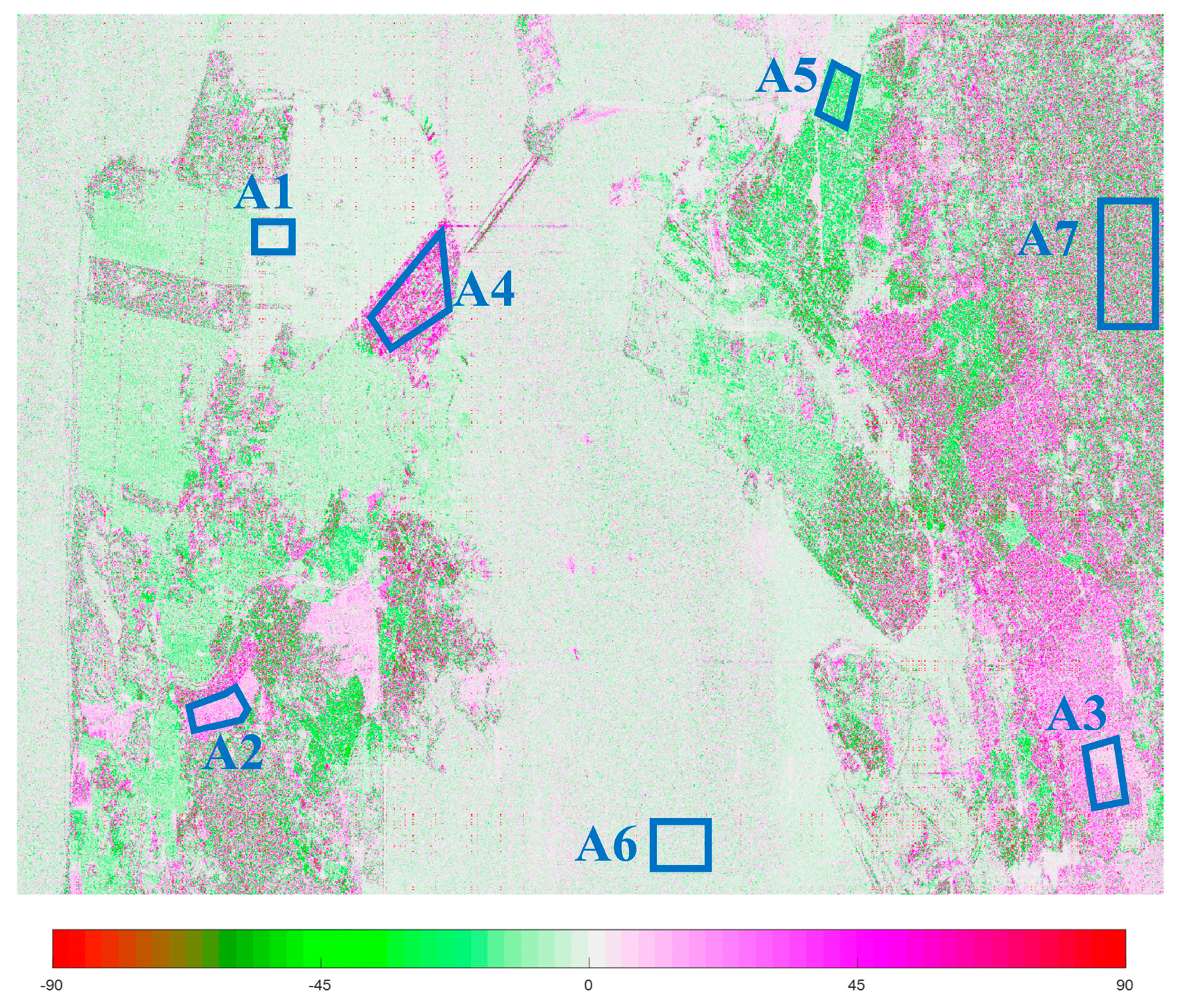
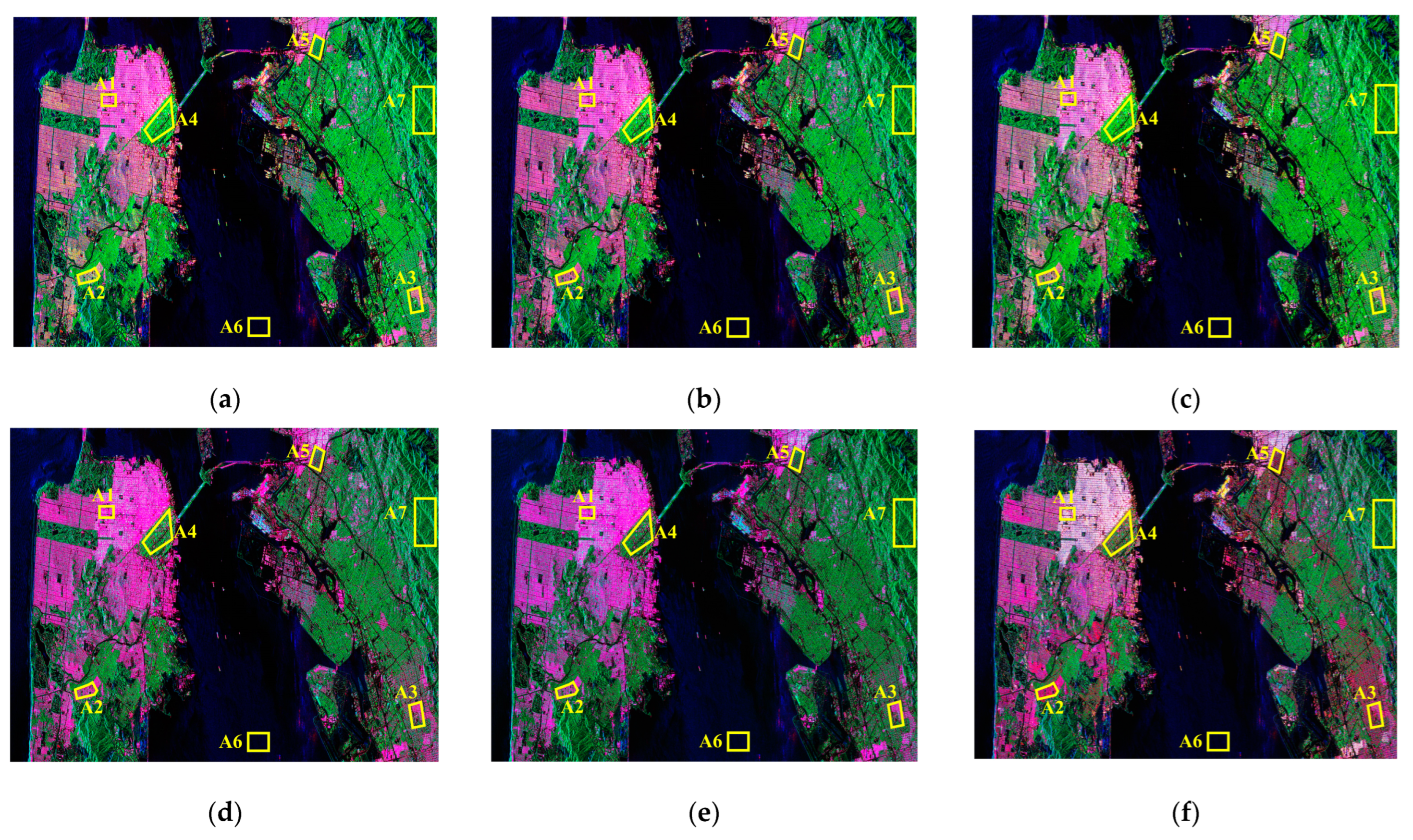
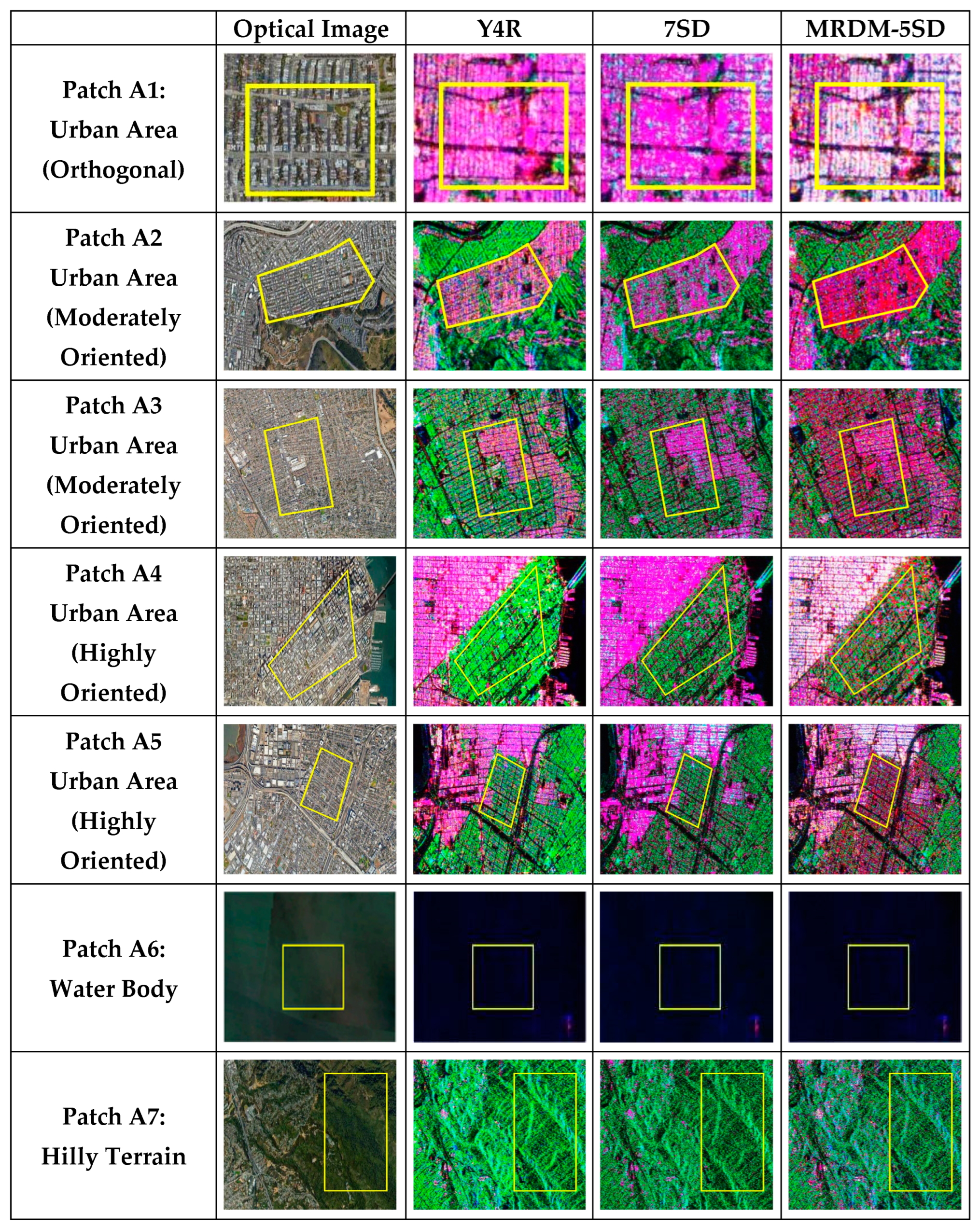
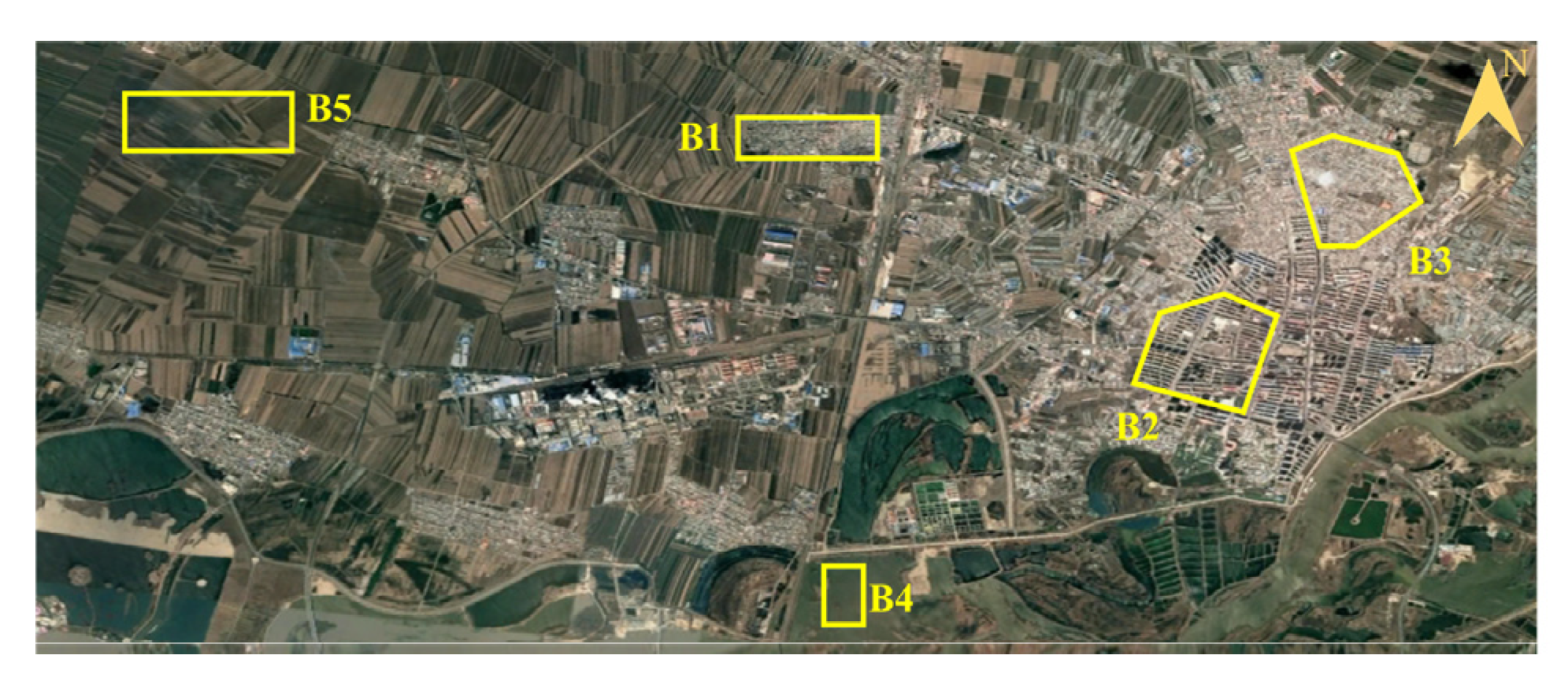


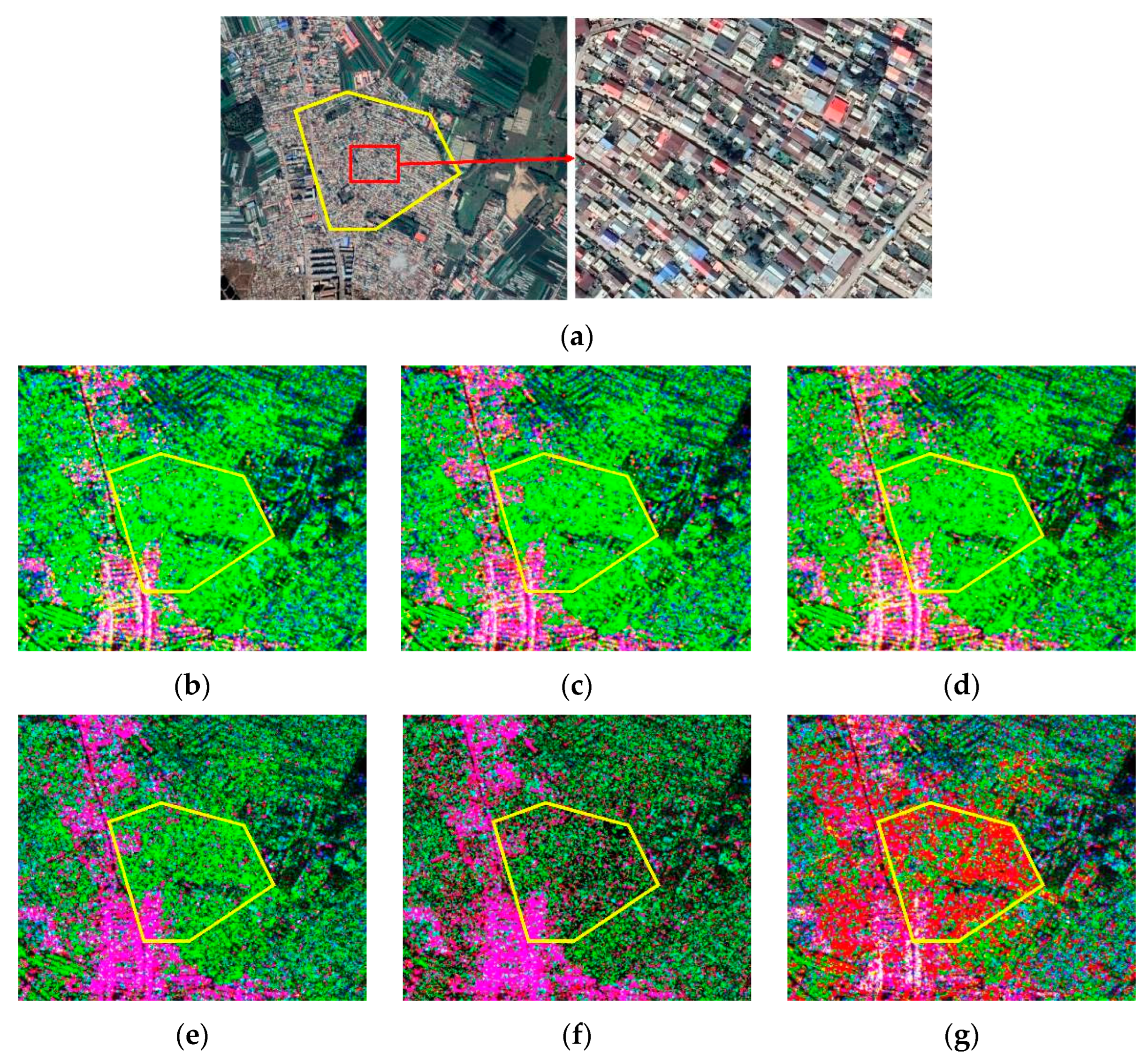


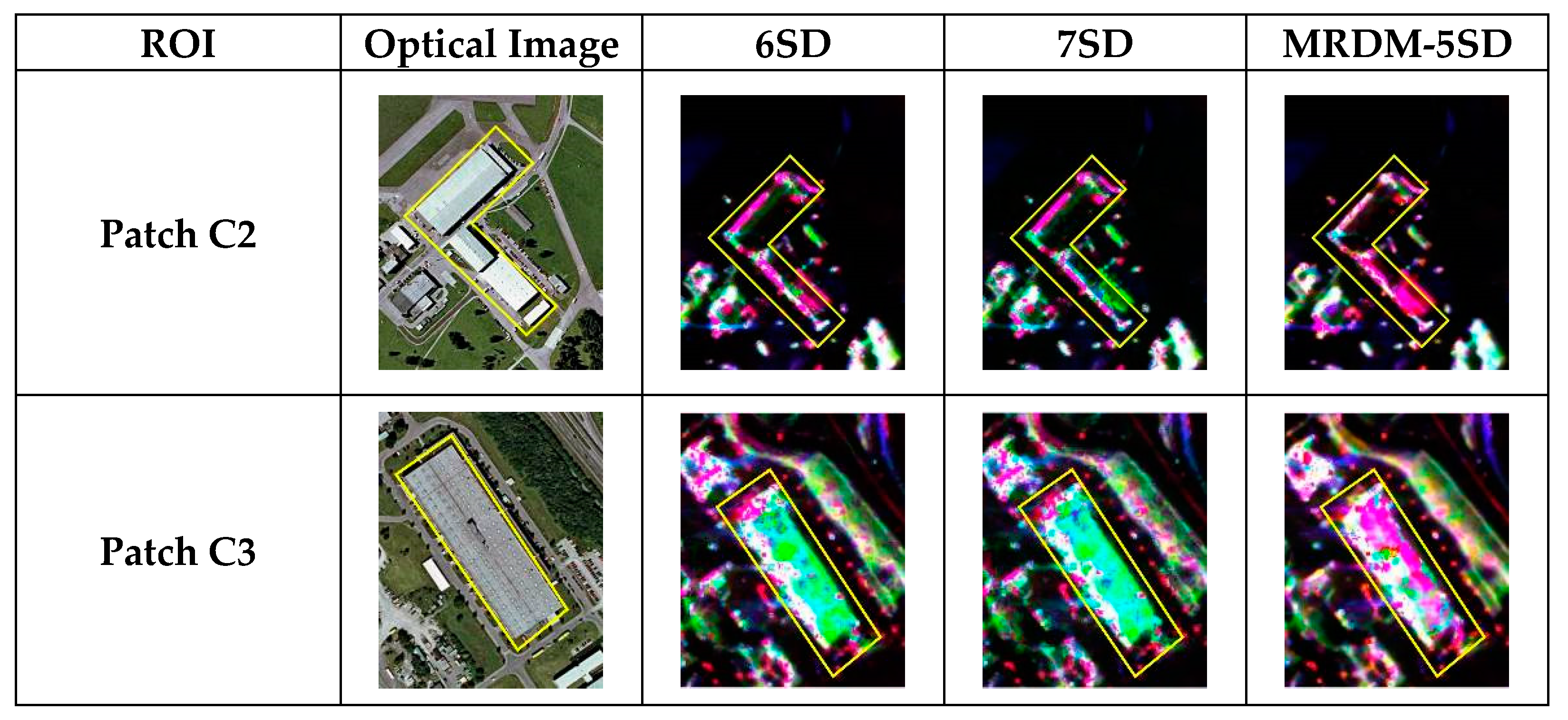


| (37) | Carrier | Band | Resolution (Azimuth × Range) | Area | Ground Objects | Acquisition Data |
|---|---|---|---|---|---|---|
| ALOS-2/ PALSAR-2 | Spaceborne | L | 3.20 m 2.86 m | San Francisco, USA | Water, hills, urban area | 2015/3/24 |
| GF-3 | Spaceborne | C | 8 m 8 m | Harbin, China | Water, farmland, urban area | 2017/7/23 |
| E-SAR | Airborne | L | 3 m 2.2 m | Oberpfaffenhofen, Germany | Vegetation, grass land, urban area, airport | 2022/8/26 |
| ROIs | Methods | |||||||
|---|---|---|---|---|---|---|---|---|
| Patch A1 | Y4O | 30.6 | 53.2 | 12.5 | 3.7 | - | - | - |
| Y4R | 32.2 | 56.6 | 8.7 | 2.5 | - | - | - | |
| G4U | 28.5 | 57.4 | 13.9 | 0.3 | - | - | - | |
| 6SD | 29.8 | 59.3 | 4.2 | 2.4 | 2.1 | 2.3 | - | |
| 7SD | 29.8 | 56.7 | 4.7 | 1.7 | 1.4 | 1.2 | 4.5 | |
| MRDM-5SD | 32.5 | 57.4 | 6.2 | - | 2.0 | 1.9 | - | |
| Patch A2 | Y4O | 21.5 | 28.2 | 42.4 | 7.9 | - | - | - |
| Y4R | 27.5 | 52.0 | 16.3 | 4.2 | - | - | - | |
| G4U | 23.0 | 53.1 | 23.5 | 0.4 | - | - | - | |
| 6SD | 24.5 | 57.0 | 7.7 | 3.3 | 3.7 | 3.8 | - | |
| 7SD | 21.7 | 44.1 | 9.5 | 1.4 | 3.7 | 2.4 | 17.2 | |
| MRDM-5SD | 19.0 | 65.1 | 3.5 | - | 7.5 | 4.9 | - | |
| Patch A3 | Y4O | 22.1 | 17.3 | 49.8 | 10.8 | - | - | - |
| Y4R | 27.4 | 29.5 | 34.5 | 8.6 | - | - | - | |
| G4U | 21.0 | 32.5 | 45.8 | 0.7 | - | - | - | |
| 6SD | 24.3 | 37.8 | 16.3 | 6.1 | 7.9 | 7.6 | - | |
| 7SD | 19.9 | 32.0 | 18.6 | 4.8 | 6.3 | 5.8 | 12.6 | |
| MRDM-5SD | 22.3 | 50.4 | 10.7 | - | 8.6 | 8.0 | - | |
| Patch A4 | Y4O | 21.0 | 10.0 | 57.2 | 11.8 | - | - | - |
| Y4R | 20.0 | 13.4 | 55.7 | 10.9 | - | - | - | |
| G4U | 17.0 | 15.1 | 67.7 | 0.2 | - | - | - | |
| 6SD | 18.4 | 22.4 | 18.3 | 7.0 | 16.0 | 17.9 | - | |
| 7SD | 19.5 | 27.0 | 12.2 | 6.0 | 12.7 | 11.0 | 11.6 | |
| MRDM-5SD | 24.0 | 42.8 | 13.2 | - | 9.2 | 10.8 | - | |
| Patch A5 | Y4O | 34.3 | 22.9 | 35.0 | 7.8 | - | - | - |
| Y4R | 37.5 | 31.2 | 25.1 | 6.2 | - | - | - | |
| G4U | 32.5 | 33.3 | 33.7 | 0.5 | - | - | - | |
| 6SD | 34.7 | 37.3 | 12.8 | 4.4 | 5.5 | 5.3 | - | |
| 7SD | 32.8 | 33.6 | 14.4 | 3.4 | 4.1 | 3.7 | 8.0 | |
| MRDM-5SD | 33.9 | 45.6 | 8.8 | - | 6.3 | 5.4 | - | |
| Patch A6 | Y4O | 78.2 | 7.8 | 8.2 | 5.8 | - | - | - |
| Y4R | 78.7 | 8.1 | 7.7 | 5.5 | - | - | - | |
| G4U | 76.1 | 8.2 | 9.3 | 6.4 | - | - | - | |
| 6SD | 65.8 | 7.3 | 9.1 | 5.8 | 6.0 | 6.0 | - | |
| 7SD | 82.1 | 4.4 | 13.1 | 0.1 | 0.1 | 0.1 | 0.1 | |
| MRDM-5SD | 82.9 | 8.8 | 7.1 | - | 0.6 | 0.6 | - | |
| Patch A7 | Y4O | 24.0 | 6.6 | 58.5 | 10.9 | - | - | - |
| Y4R | 25.5 | 10.2 | 53.7 | 10.6 | - | - | - | |
| G4U | 19.6 | 13.5 | 66.0 | 0.9 | - | - | - | |
| 6SD | 23.1 | 18.1 | 31.7 | 6.9 | 10.2 | 10.0 | - | |
| 7SD | 20.2 | 15.9 | 34.2 | 5.9 | 9.0 | 8.8 | 6.0 | |
| MRDM-5SD | 26.7 | 22.5 | 32.0 | - | 9.5 | 9.3 | - |
| ROIs | Methods | |||||||
|---|---|---|---|---|---|---|---|---|
| Patch B1 | Y4O | 25.4 | 52.8 | 17.1 | 4.7 | - | - | - |
| Y4R | 26.2 | 57.0 | 13.4 | 3.4 | - | - | - | |
| G4U | 22.9 | 58.2 | 18.8 | 0.1 | ||||
| 6SD | 22.3 | 62.5 | 6.7 | 3.1 | 2.7 | 2.7 | - | |
| 7SD | 22.1 | 60.6 | 6.4 | 2.6 | 2.2 | 2.0 | 4.1 | |
| MRDM-5SD | 22.9 | 61.2 | 10.6 | - | 2.7 | 2.6 | - | |
| Patch B2 | Y4O | 8.9 | 22.3 | 55.3 | 13.5 | - | - | - |
| Y4R | 10.7 | 42.6 | 38.7 | 8.0 | - | - | - | |
| G4U | 8.6 | 43.9 | 47.4 | 0.1 | - | - | - | |
| 6SD | 10.4 | 45.8 | 9.7 | 8.5 | 16.1 | 9.5 | - | |
| 7SD | 10.1 | 40.4 | 3.9 | 6.1 | 11.3 | 5.6 | 22.6 | |
| MRDM-5SD | 9.0 | 67.2 | 7.5 | - | 10.3 | 6.0 | - | |
| Patch B3 | Y4O | 6.6 | 7.0 | 76.2 | 10.2 | - | - | - |
| Y4R | 6.7 | 10.5 | 73.4 | 9.4 | - | - | - | |
| G4U | 5.3 | 11.0 | 83.6 | 0.1 | - | - | - | |
| 6SD | 5.5 | 12.8 | 22.6 | 7.5 | 27.7 | 23.9 | - | |
| 7SD | 5.3 | 13.6 | 6.8 | 5.2 | 23.4 | 20.6 | 25.1 | |
| MRDM-5SD | 8.4 | 60.6 | 13.8 | - | 8.5 | 8.7 | - | |
| Patch B4 | Y4O | 36.3 | 11.9 | 39.8 | 12.0 | - | - | - |
| Y4R | 37.8 | 15.1 | 36.4 | 10.7 | - | - | - | |
| G4U | 30.9 | 17.8 | 47.6 | 3.7 | - | - | - | |
| 6SD | 26.3 | 23.8 | 21.0 | 6.9 | 11.4 | 10.6 | - | |
| 7SD | 21.6 | 27.9 | 22.6 | 4.8 | 10.1 | 8.9 | 4.1 | |
| MRDM-5SD | 34.2 | 26.7 | 23.1 | - | 8.3 | 7.7 | - | |
| Patch B5 | Y4O | 14.1 | 1.2 | 71.2 | 13.5 | - | - | - |
| Y4R | 13.4 | 2.6 | 70.9 | 13.1 | - | - | - | |
| G4U | 9.8 | 4.0 | 86.1 | 2.1 | - | - | - | |
| 6SD | 12.2 | 7.6 | 35.3 | 9.1 | 17.7 | 18.1 | - | |
| 7SD | 10.6 | 9.3 | 30.9 | 8.1 | 16.4 | 16.7 | 8.0 | |
| MRDM-5SD | 18.4 | 16.9 | 37.8 | - | 13.2 | 13.7 | - |
| ROIs | Methods | |||||||
|---|---|---|---|---|---|---|---|---|
| Patch C1 | Y4O | 33.0 | 54.2 | 11.1 | 1.7 | - | - | - |
| Y4R | 33.2 | 54.6 | 10.6 | 1.6 | - | - | - | |
| G4U | 31.1 | 54.6 | 13.9 | 0.4 | - | - | - | |
| 6SD | 32.9 | 56.9 | 5.8 | 1.5 | 1.6 | 1.3 | - | |
| 7SD | 34.0 | 56.0 | 4.9 | 1.3 | 0.8 | 1.2 | 1.8 | |
| MRDM-5SD | 31.3 | 56.0 | 10.4 | - | 1.3 | 1.0 | - | |
| Patch C2 | Y4O | 24.1 | 21.9 | 48.4 | 5.6 | - | - | - |
| Y4R | 27.2 | 28.0 | 39.4 | 5.4 | - | - | - | |
| G4U | 21.8 | 29.2 | 48.4 | 0.6 | - | - | - | |
| 6SD | 20.8 | 38.4 | 17.7 | 2.1 | 8.9 | 12.1 | - | |
| 7SD | 20.8 | 36.7 | 19.4 | 2.0 | 2.0 | 19.7 | 5.4 | |
| MRDM-5SD | 26.2 | 47.8 | 17.1 | - | 5.2 | 3.7 | - | |
| Patch C3 | Y4O | 57.6 | 5.8 | 31.1 | 5.5 | - | - | - |
| Y4R | 65.4 | 12.3 | 18.6 | 3.7 | - | - | - | |
| G4U | 66.0 | 9.9 | 24.0 | 0.1 | - | - | - | |
| 6SD | 50.2 | 23.8 | 20.5 | 1.5 | 2.5 | 1.5 | - | |
| 7SD | 34.9 | 9.3 | 48.0 | 2.2 | 1.5 | 1.7 | 2.4 | |
| MRDM-5SD | 52.7 | 32.0 | 11.5 | - | 3.1 | 0.7 | - | |
| Patch C4 | Y4O | 80.7 | 7.6 | 5.9 | 5.8 | - | - | - |
| Y4R | 80.5 | 7.8 | 5.9 | 5.8 | - | - | - | |
| G4U | 80.3 | 7.9 | 6.0 | 5.8 | - | - | - | |
| 6SD | 71.7 | 7.3 | 5.3 | 5.2 | 5.3 | 5.2 | - | |
| 7SD | 86.6 | 8.2 | 4.2 | 0.2 | 0.3 | 0.3 | 0.2 | |
| MRDM-5SD | 86.5 | 8.7 | 3.5 | - | 0.6 | 0.7 | - | |
| Patch C5 | Y4O | 21.0 | 26.8 | 49.7 | 2.5 | - | - | - |
| Y4R | 21.2 | 26.9 | 49.3 | 2.6 | - | - | - | |
| G4U | 18.3 | 27.8 | 53.5 | 0.4 | - | - | - | |
| 6SD | 24.8 | 30.0 | 36.8 | 2.6 | 3.1 | 2.7 | - | |
| 7SD | 27.5 | 28.7 | 32.9 | 2.4 | 2.9 | 2.9 | 2.7 | |
| MRDM-5SD | 25.3 | 22.3 | 48.2 | - | 2.2 | 2.0 | - |
| Decomposition Methods | Precision Rate (%) | False Alarm Rate (%) | Miss Rate (%) |
|---|---|---|---|
| Y4R | 87.50 | 4.83 | 6.00 |
| G4U | 85.03 | 6.00 | 5.35 |
| 6SD | 85.14 | 5.96 | 5.14 |
| 7SD | 85.54 | 5.63 | 7.40 |
| MRDD-5SD | 92.33 | 2.87 | 3.88 |
Disclaimer/Publisher’s Note: The statements, opinions and data contained in all publications are solely those of the individual author(s) and contributor(s) and not of MDPI and/or the editor(s). MDPI and/or the editor(s) disclaim responsibility for any injury to people or property resulting from any ideas, methods, instructions or products referred to in the content. |
© 2022 by the authors. Licensee MDPI, Basel, Switzerland. This article is an open access article distributed under the terms and conditions of the Creative Commons Attribution (CC BY) license (https://creativecommons.org/licenses/by/4.0/).
Share and Cite
Chen, Y.; Zhang, L.; Zou, B.; Gu, G. Polarimetric SAR Decomposition Method Based on Modified Rotational Dihedral Model. Remote Sens. 2023, 15, 101. https://doi.org/10.3390/rs15010101
Chen Y, Zhang L, Zou B, Gu G. Polarimetric SAR Decomposition Method Based on Modified Rotational Dihedral Model. Remote Sensing. 2023; 15(1):101. https://doi.org/10.3390/rs15010101
Chicago/Turabian StyleChen, Yifan, Lamei Zhang, Bin Zou, and Guihua Gu. 2023. "Polarimetric SAR Decomposition Method Based on Modified Rotational Dihedral Model" Remote Sensing 15, no. 1: 101. https://doi.org/10.3390/rs15010101
APA StyleChen, Y., Zhang, L., Zou, B., & Gu, G. (2023). Polarimetric SAR Decomposition Method Based on Modified Rotational Dihedral Model. Remote Sensing, 15(1), 101. https://doi.org/10.3390/rs15010101






